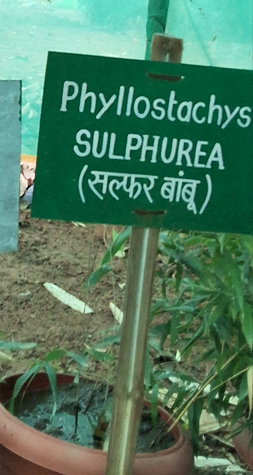Phyllostachys sulphurea

Phyllostachys sulphurea
Phyllostachys sulphurea, commonly known as Sulphur Bamboo in English and (Huáng zhú) in Chinese, is also referred to as Huang Zhu in Chinese and Sulphur Bamboo in Hindi. Native to central and southern China, it thrives in subtropical and temperate regions. It has been introduced to Japan, Taiwan, and parts of Southeast Asia, primarily for ornamental and landscaping purposes.
Phyllostachys sulphurea grows in a clumping, erect manner with thick culms. It typically reaches a height of 8 to 12 meters and has a diameter of 4 to 8 cm. The culms are bright yellow, turning slightly darker with age. The internode length ranges from 20 to 30 cm, and the culm sheath is green when young and deciduous. The adaxial surface of the culm is glabrous, while the abaxial surface is covered with a light layer of fine hairs, and the margins are ciliate.
The leaves of Phyllostachys sulphurea are narrow and lanceolate in shape, with a sharp point. They measure 10 to 15 cm in length and 1.5 to 3 cm in breadth. The leaves are glossy green with a smooth surface, adding to the plant's visual appeal.
This bamboo species prefers low to medium altitudes, ranging from 200 to 1,500 meters above sea level, and grows best in fertile, well-drained soils that are slightly acidic to neutral. It is tolerant of various soil types, including clay and loamy soils.
The inflorescence of Phyllostachys sulphurea consists of large panicles with spicate branching. The flowering glumes are small, light brown, and ovate to elliptic in shape. The stamens are 6 to 8 and are exserted beyond the flowers. Flowering in Phyllostachys sulphurea is infrequent, occurring once every 40 to 60 years, with flowering events reported rarely in select locations in China.
The seeds of this bamboo species are small, lightweight, and wind-dispersed, though germination is slow due to infrequent flowering and low seed viability. Culm cuttings are the most common method of propagation, as they root easily and quickly. Clump division is another method, allowing for faster growth by dividing mature plants. Seed propagation is less common due to the long intervals between flowering events.
Phyllostachys sulphurea is highly valued for its striking yellow culms, making it a popular choice for ornamental and landscaping purposes. It is also used for light construction, such as furniture and handicrafts, thanks to its strong, flexible stems. Traditional uses in its native regions include the making of poles, scaffolding, and small structures. Additionally, Phyllostachys sulphurea is used in the production of various bamboo crafts, including baskets and woven items.
In summary, Phyllostachys sulphurea is an ornamental and versatile bamboo species, prized for its unique yellow culms and a wide range of uses, from construction to traditional crafts. Its slow propagation and infrequent flowering are offset by its easy cultivation through culm cuttings and clump division.
Listen Audio:
Need assistance? BRTC Faculty